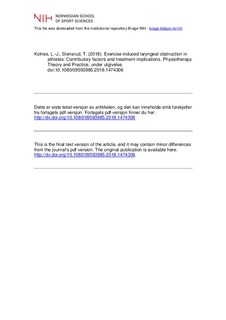| dc.contributor.author | Kolnes, Liv-Jorunn | |
| dc.contributor.author | Stensrud, Trine | |
| dc.date.accessioned | 2019-05-15T14:37:35Z | |
| dc.date.available | 2019-05-15T14:37:35Z | |
| dc.date.created | 2019-01-28T21:42:31Z | |
| dc.date.issued | 2018 | |
| dc.identifier.citation | Physiotherapy Theory and Practice. 2018, 34, 1-12. | nb_NO |
| dc.identifier.issn | 0959-3985 | |
| dc.identifier.uri | http://hdl.handle.net/11250/2597735 | |
| dc.description | I Brage finner du siste tekst-versjon av artikkelen, og den kan inneholde ubetydelige forskjeller fra forlagets pdf-versjon. Forlagets pdf-versjon finner du på tandfonline.com / In Brage you'll find the final text version of the article, and it may contain insignificant differences from the journal's pdf version. The definitive version is available at tandfonline.com | nb_NO |
| dc.description.abstract | Otherwise healthy adolescent athletes presenting with respiratory symptoms consistent with exercise-induced laryngeal obstruction (EILO) are frequently encountered in clinical practice. The symptoms are often incorrectly considered to result from exercise-induced asthma, and may be wrongly treated as such. Given the potential implications for health and performance if EILO is left untreated, a more comprehensive understanding of contributory mechanisms is essential in order to create appropriate treatment procedures. Informed by knowledge from physical therapy, as well as the fields of voice rehabilitation and vocal pedagogy, this theoretical article presents a novel way of understanding and managing EILO by exploring bodily mechanisms and structures that may disturb laryngeal function during strenuous exercise. Firstly, the status quo of the EILO diagnosis, its aetiology and treatment options are reviewed. Secondly, considerations associated with laryngeal structures and mechanisms, and their potential influence on laryngeal movement and sensitivity are examined. Thirdly, the manner in which postural de-alignment and breathing pattern may interfere with laryngeal functioning will be discussed. Finally, interventions for voice disorders and singing and the relevance of these for EILO are evaluated. It is argued that clients with EILO should undergo a thorough physical examination to identify constrictions in the body as a whole – such as postural de-alignments and a dysfunctional breathing pattern – as these are hypothesized as playing a critical role in laryngeal tightness during exercise. Physical therapists possess particular skills and competence with regard to examining breathing patterns and postural de-alignments, and should be included in the treatment process of EILO. | nb_NO |
| dc.language.iso | eng | nb_NO |
| dc.subject | breathing pattern | nb_NO |
| dc.subject | physical therapy | nb_NO |
| dc.subject | posture | nb_NO |
| dc.subject | whole body approach | nb_NO |
| dc.title | Exercise-induced laryngeal obstruction in athletes: Contributory factors and treatment implications | nb_NO |
| dc.type | Journal article | nb_NO |
| dc.type | Peer reviewed | nb_NO |
| dc.description.version | acceptedVersion | nb_NO |
| dc.source.pagenumber | 12 | nb_NO |
| dc.source.journal | Physiotherapy Theory and Practice | nb_NO |
| dc.identifier.doi | 10.1080/09593985.2018.1474306 | |
| dc.identifier.cristin | 1666955 | |
| dc.description.localcode | Seksjon for idrettsmedisinske fag / Department of Sport Medicine | nb_NO |
| cristin.unitcode | 150,34,0,0 | |
| cristin.unitname | Seksjon for idrettsmedisinske fag | |
| cristin.ispublished | true | |
| cristin.fulltext | postprint | |
| cristin.qualitycode | 2 | |
